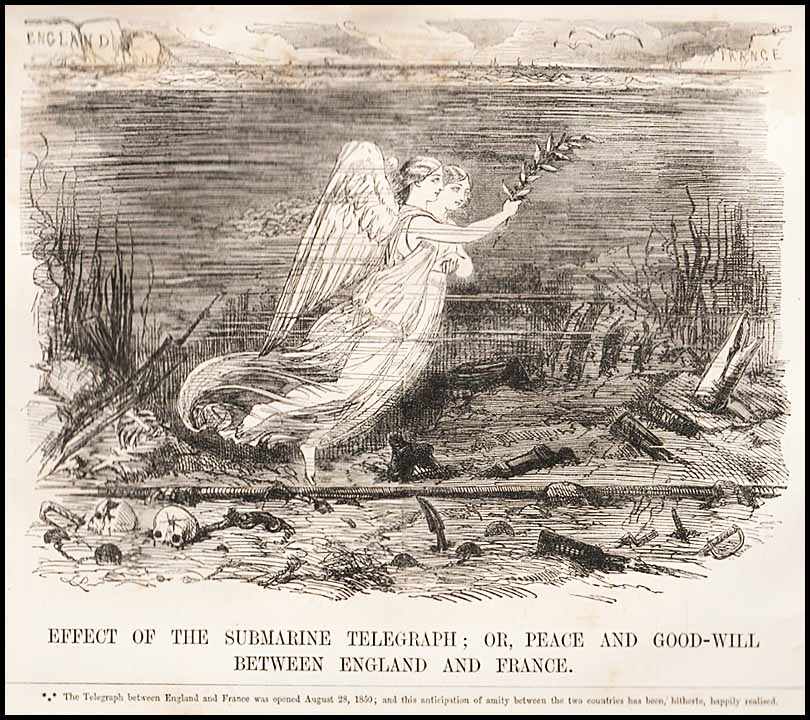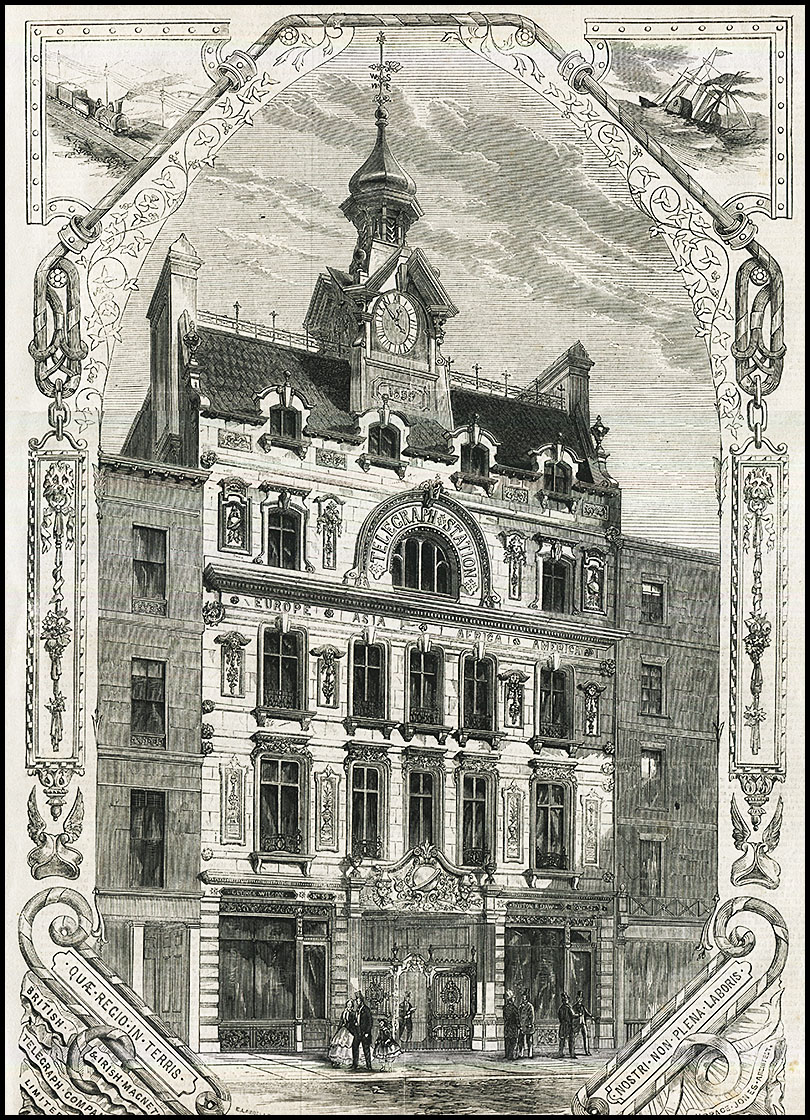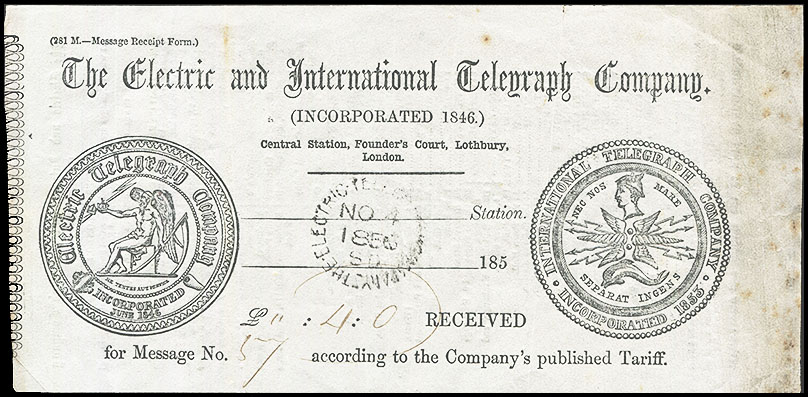The beginning of international links.
- Australia 1901-1988
- New South Wales
- Queensland
- South Australia
- Tasmania
- Victoria
- Western Australia
- International
- Special aspects
Thoughts turn to international telegraphy.
By about 1840, communication by telegraph had been shown to be moderately successful on land. The problem was however that, in Europe and America, the emerging telegraphic networks were being operated by hundreds of small independent companies whose lines did not connect. Finance was scarce - especially in America due to the Civil War and the Union breaking up.
Once the feasibility of using telegraphic communication across long distances had been established in various places, the possibility of sending communications between neighbouring countries was deemed to be the essential next step. This possibility could of course be easily achieved in Europe - as long as you could trust those of the other side of your border. Generally this was possible but not always.
Starting in the 1840s, submarine cables became the focus of considerable activity aimed at developing the far-from-perfect technology whch had hindered their use. Such technology would allow connections - especially for commercial and political purposes - between:
- Britain and Ireland and the Channel Islands;
- Britain and European countries especially France and the Netherlands;
- European countries - especially from France (Marseilles) - and Aden;
- Britain and America;
- Newfoundland and America;
- Aden/ Suez and India.
- India and Australia
At first submaribe cable technology could only be described as being highly unsuccessful. In the Australian Colonial context, the ambitions of people - especially Charles Todd and Samuel McGowan, were in common with those of visionaries in Europe and the Americas who, almost from the start of telegraphic communications, dreamt of extending the telegraph technology to reach distant shores.
There were various ways in which international connections might be made - see the visionary concepts embodied in one of the early Austalian Colonial proposals - and the major benefits which would accur would be so significant as to be immesurable. In 1859, for example, after the initial strategies in Victoria, South Australia and New South Wales had been implemented, it was known that a possible international telegram would be very much quicker that the ship mail. The following description from the Sydney Morning Herald of 26 November 1959, shows what was then required:
"The telegraph, as far as it is complete, is already available for Australian merchants. Messages can be posted to Aden, whence they will be telegraphed to Alexandria, and posted again to Marseilles, and telegraphed again direct to London. By this means over fifteen days may at present be saved on the ordinary postal service from Sydney, by making use of the intercolonial telegraph to Adelaide".
The beginning of submarine technology.
Perhaps the first submarine cable was developed by Samuel Morse. In 1842, he coated a wire with rubber and inserted that into a lead pipe. He then laid this wire between Castle Garden and Governors Island in New York Harbour. A telegraphic message was communicated through the wire over that short distance but it was impracticable over a longer distance. Experiments were soon conducted to determine how heavy the cable should be and how best to protect the cables from changing resistance to electrical conductivity and from seawater corrosion (see Wikipedia).
The various problems in America slowed the development effort there and so attention changed to laying a cable across the English Channel. Europe was by then criss-crossed with long telegraph wires - but England was isolated. As lead pipe could not be used over such distances, technicians experimented with rubber coverings around the telegraph wires but it was soon discovered that rubber quickly deteriorated in sea water.
The first cable across the English Channel.
Gutta-percha was used to coat the cable used for the first attempt to lay a submarine cable across the English Channel. The Brett brothers obtained the necessary permissions and embarked on their project. John was a retired antique dealer while his younger brother Jacob was an engineer.
They contacted the newly established Gutta-Percha Company in London and ordered a wire coated with a quarter of an inch of gutta-percha - which made it about as thick as a power cord used today.
On 28 August 1850, they loaded the cable wrapped around a steel drum on the back of a small tug boat called the Goliath and set sail for Cap Gris-Nez near Calais in France. It was not long before they realised that the cable was so light that it floated. They solved that problem by adding weights at regular intervals to force it to the bottom.
After arrival, they attached the latest telegraphic technology to the cable and sent the first test message. Unfortunately it was indecipherable because the water around the cable changed the electrical properties and the dots and dashes of the morse code were smoothed out. They then used an older-style machine to slow the transmission speed and did achieve some success. Their happiness in this qualified success sank the following day when a French fisherman caught the cable in his net and dragged it to the surface. As Standage (1998, 72) describes "he hacked off a piece to see what it was. Deciding that it was a hitherto unknown form of seaweed with a gold centre, he took it to show his friends in Boulogne".
The Brett brothers developed their ideas further (apparently independemt of the fisherman) and achieved success in September 1851 by installing an armored cable between Dover and Calais that lasted for many years under the name of their company Submarine Telegraph Company between France and England (see elsewhere also).
|
1849: The British Electric Telegraph Company was the first competitor to the ETC.
1851: The English and Irish Magnetic Telegraph Company (later renamed the British and Irish Magnetic Company). This company was established by John Brett. One of his colleagues was John Pender - who became one of the most important figures in cable telegraphy as far as Australia was concerned and also for tthe laying of the Atlantic Cable.
The Company adopted a system to generate the impulses electro-magnetically through its cables and this was a different strategy to that used by ETC. This company buried its cables along highways. Eventually the Magnetic (as it became known) took over the ETC.
The first working cable laid to Ireland was that between Portpatrick and Donaghadee in 1853.
| The English and Irish Magnetic Telegraph Company. | 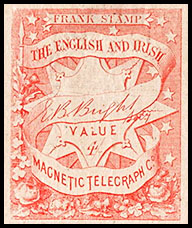 |
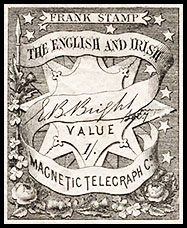 |
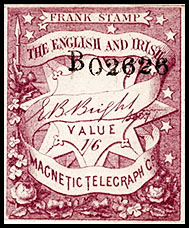 |
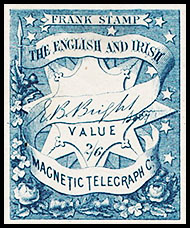 |
| The British and Irish Magnetic Telegraph Company. | 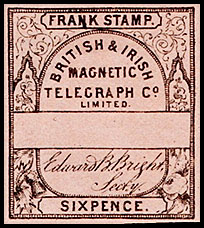 |
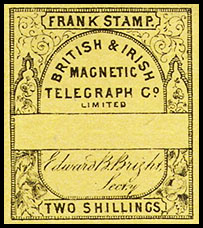 |
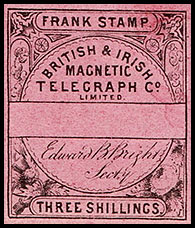 |
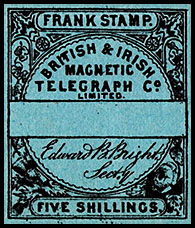 |
| Examples of Frank Stamps to receipt the payment of telegram costs at the two companies. | ||||
|
1853: The International Cable Company was formed to lay cables to the Netherlands between Orfordness (on the Suffolk Coast) and Scheveningen (The Hague). It was formed to overcome the objection of the Dutch Government to ETC laying cables on Dutch soil. The C.S. Monarch was used for the first time and completed the task in 1854.A major problem which developed was that the cable need considerable maintenance and so it was replaced in 1858.
1854: Cooke's ETC merged with the International Telegraph Company. The combined company was called the Electric and Internatonal Telegraph Company. This company became significantly involved in laying submarine cables.
|
|
Once a cable across the English Channel worked successfully for the Brettt brothers, ambitions turned to crossing the Atlantic. Laying a telegraphic cable across the Atlantic was first tried in 1854. Although unsuccessful, it was followed by four major attempts to make the crossing. The first thrre - in 1857, 1858 and 1865 were unsuccessful for various easons. Finally, in 1866, telegraphic communication across the Atlantic was successfully achieved There are many descriptions of these efforts and some of these can be referenced elsewhere in the many reports and narratives about this massive undertaking.
The main player in the attempts to communicate across the Atlantic emerged as being Mr. (later Sir) John Pender who was a member of the English House of Commons. He had major financial interests in cotton - most of which he imported into England from America. He therefore understood the importance of and need for rapid and reliable international communication. He became interested in attempts to develop submarine telegraphic technology. As noted above, in 1851 he became involved with the British and Irish Telegraph Company and he was a financial supporter of the 1858 failed attempt to lay a trans-Atlantic cable. In 1864. John Pender formed the Telegraph Construction and Maintenance Company to manufacture and operate the telegraphic cable across the Atlantic. From that basis, Pender established a series of companies to lay cables to the various British Colonies including India, the Far East and Australia. In 1872, all these companies were merged into the Eastern Telegraph Company (see the first telegraph forms used in Australia). |
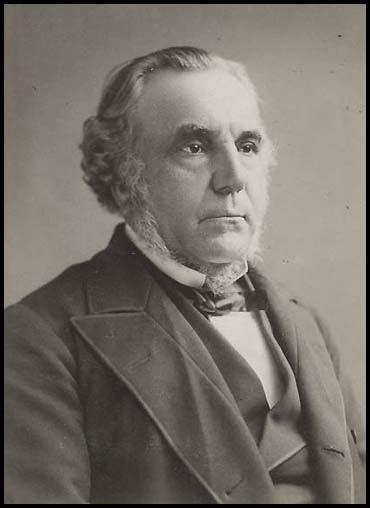 John Pender. |
In the late 1850s, the American Telegraph Company emerged as the dominant American telegraphic company - especially in the eastern states. After the 1865 attempt to cross the Atlantic failed, that Company was ruined. Pender therefore took it over and provided the required additional financial support. He renamed it the Anglo-American Telegraph Company. Indeed, Pender had to give his personal guarantee of £500,000 before cable manufacturers would commence work on manufacturing another cable.
In 1864, the Gutta Percha Company, which had manufactured the core for the first trans-Atlantic cable, merged with Glass, Elliott & Company, which had made the sheathing for that first successful cable. Soon after, the Anglo-American Telegraph Company also joined the group to form the Telegraph Construction & Maintenance Company - under Pender's directorship.
That Company was to dominate submarine telegraph cable manufacture and operation for the next 100 years.
| There was great jubilation on both sides of the Atlantic when Pender's Companies established successful communication.
Soon after, on 18 August 1866, Harper's Weekly, reported: "The cable thus far works with success but the means of communication between our great cities and Heart's Content are provokingly inadequate and are not to be relied upon for promptness. This difficulty will soon be remedied and then we shall be able to read in the morning papers all the important European news of the previous day. At the office in this city, of which we give an illustration (at right) telegrams for Europe are daily received at an expense to the sender of about a dollar per letter. Already the monetary quotations in this city and London are becoming equalized and the uncertainty and suspense which have hitherto acted as disturbance elements are becoming obviated". |
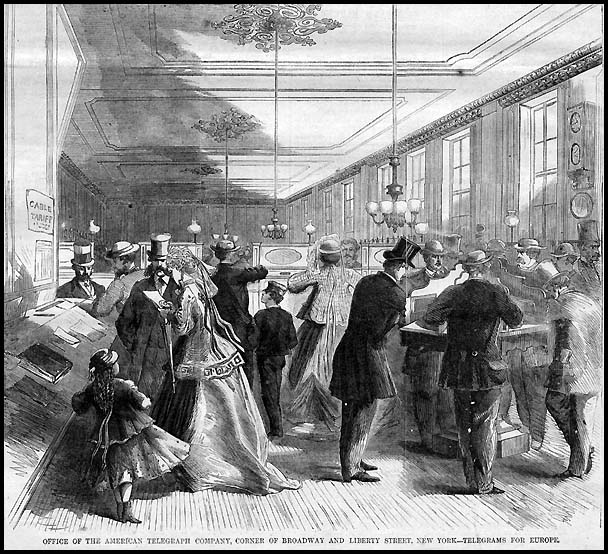 Telegrams for Europe. Office of the American Telegraph Company, corner of Broadway and Liberty Street, New York. |
The next challenge facing the various telegraphic companies - but especially Pender's Telegraph Construction & Maintenance Company - was the establishment of telegraphic communication with India and China.
